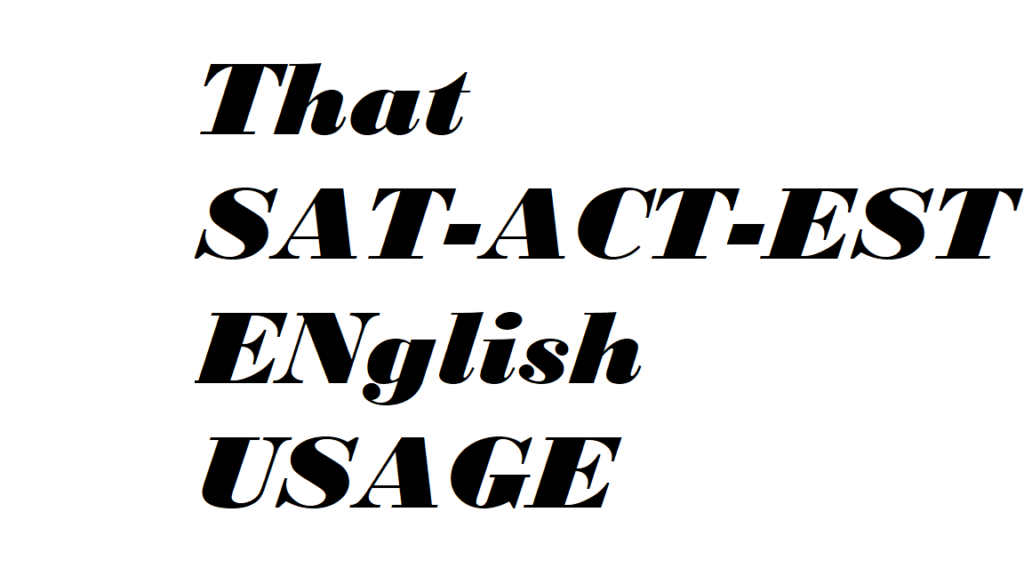“That” has multi usages in ACT, Digital SAT, and EST. That can serve different functions depending on how it is used in a sentence. Here are some common uses of “that” in ACT, Digital SAT, and EST:
That as demonstrative pronoun ACT, SAT, EST:
As a demonstrative pronoun, “that” is used to indicate something specific that is farther away in space or time.
Example: “That is my house.”
“That” can also be used as a demonstrative pronoun in relative clauses to introduce essential information about a noun. In such cases, “that” is usually followed by a verb.
For example:
“The book that you recommended is excellent.”
“She is the person that we were talking about.”
In these sentences, “that” is used as a relative pronoun to connect the dependent clause to the noun it describes. It helps to specify which book or person is being referred to.
Additionally, “that” can be used as a demonstrative pronoun to introduce a clause that provides further explanation or clarification about a preceding noun or pronoun.
For instance:
“She said that she would be late.”
“I believe that we can achieve our goals.” In these cases, “that” is used as a subordinating conjunction to connect the main clause with the subordinate clause, providing additional information or context.
As a relative pronoun, “that” is used to introduce a restrictive clause that provides essential information about a noun.
That as relative pronoun ACT, SAT, EST:
When “that” is used as a relative pronoun, it serves to introduce a relative clause that provides essential information about a noun. Here is a more detailed explanation of “that” as a relative pronoun:
Function:
Introducing Essential Information: “That” is used to introduce a clause that is essential to the meaning of the sentence. It helps to specify or identify the noun it refers to.
Examples:
“The car that I bought is red.”
Defining a Noun:
“The car that I bought is red.”
“She is the woman that won the award.”
Referring to Objects:
“The pen that I lost was expensive.”
“He showed me the house that he built.”
Characteristics:
Omitting “That”: In many cases, “that” can be omitted without changing the meaning of the sentence, especially in spoken English.
“The book that I read” can also be expressed as “The book I read.”
Restrictive Clauses: The clauses introduced by “that” are often essential to clearly identify or define the noun they refer to. These are known as restrictive clauses.
Verb Follows “That”: In relative clauses using “that,” the verb usually comes immediately after “that.”
“The book that she recommended is excellent.”
Example: “The book that I bought is on the table.”
That as a Conjunction ACT, SAT, EST:
When “that” is used as a conjunction in English, it serves to introduce a clause that provides more information about a preceding statement. Here is a comprehensive explanation of “that” as a conjunction:
Function:
Introducing Subordinate Clauses: “That” is used as a subordinating conjunction to introduce a dependent clause that gives additional information about the main clause.
Examples:
Reporting Verbs:
“She said that she would be late.”
“He believes that we can succeed.”
Indicating Purpose or Result:
“They studied hard so that they could pass the exam.”
“He ran so fast that he won the race.”
Characteristics:
Linking Independent and Dependent Clauses: The use of “that” as a conjunction establishes a relationship between the main clause and the subordinate clause.
Main Clause + “that” + Subordinate Clause
Verb Following “That”: In sentences where “that” introduces a clause, a verb typically follows immediately after “that.”
“She mentioned that she was going on vacation.”
Omitting “That”: In some cases, “that” can be omitted without changing the meaning of the sentence, especially in informal contexts.
“She told me that she was coming” can also be expressed as “She told me she was coming.”
Other Uses of “That”:
Relative Pronoun: In addition to its role as a conjunction, “that” can function as a relative pronoun to introduce essential information about a noun.
“The book that I read was fascinating.”
In essence, “that” as a conjunction helps to connect ideas within a sentence, indicating the relationship between the main statement and the additional information provided by the subordinate clause.
“That” can be used as a conjunction to introduce a clause that complements the main clause.
Example: “She said that she would come.”
That as Determiner in SAT, ACT, EST:
When “that” is used as a determiner in English, it functions to specify a particular noun or noun phrase, indicating a specific or previously mentioned item. Here is a detailed explanation of “that” as a determiner:
Function:
Specifying or Identifying: As a determiner, “that” specifies or identifies a particular noun or noun phrase, distinguishing it from others.
Examples:
Demonstrating Specificity:
“Give me that book.”
“Look at that car.”
Pointing to a Specific Item:
“I want that one over there.”
“Those are those shoes I was talking about.”
Characteristics:
Pointing to Objects: “That” as a determiner often points to something specific, either physically present or previously mentioned.
Singular or Plural: “That” can be used with both singular and plural nouns, indicating specificity in either case.
Distance: “That” can sometimes indicate a certain distance, whether physical or metaphorical, from the speaker or the listener.
Other Uses of “That”:
Demonstrative Pronoun: Besides being a determiner, “that” can also function as a demonstrative pronoun when it stands alone to represent a specific object.
“I want that.”
Relative Pronoun: Additionally, “that” can work as a relative pronoun to introduce essential information about a noun in a relative clause.
“The house that we visited was beautiful.”
In essence, “that” as a determiner in English serves to specify or point out a particular item, helping to clarify which specific noun is being referred to in a sentence.
“That” can also be used as a determiner to specify a particular person or thing.
Example: “Give me that book.”
That as an adverb SAT, ACT, EST:
In English grammar, “that” can also function as an adverb in certain contexts. Here is a detailed explanation of “that” as an adverb:
Function:
Introducing Clauses or Expressing Degree: As an adverb, “that” is used to introduce clauses, express degree, or modify verbs, adjectives, or other adverbs.
Examples:
Introducing Clauses:
“She is so tired that she can’t stay awake.”
“He spoke so softly that I could barely hear him.”
Expressing Degree:
“It was that hot in the room.”
“He is that good at basketball.”
Characteristics:
Introducing Result or Purpose Clauses: “That” as an adverb is often used to introduce result or purpose clauses, indicating the consequence or reason for the main clause.
Emphasizing Degree: In some cases, “that” is used to emphasize the degree or extent of an action or quality.
Functioning as an Intensifier: “That” can act as an intensifier, adding emphasis to the following word or phrase.
Other Uses of “That”:
Conjunction: “That” can also function as a conjunction to introduce subordinate clauses that provide additional information or context.
“She said that she would call later.”
Determiner or Pronoun: In addition to being an adverb, “that” can act as a determiner to specify a particular noun or as a pronoun to stand for a specific object.
In summary, “that” as an adverb in English serves to introduce clauses, express degree, emphasize intensity, or provide additional context or information within a sentence. In some cases, “that” can function as an adverb, often emphasizing a comparison or expressing a result.
Example: “She sings better than that.”
Connector in Reported Speech:
In reported speech, “that” is often used as a connector to introduce what someone else has said.
Example: “She said that she was tired.”
These are just some of the ways “that” can be used in English grammar. Its versatility makes it a common and important word in the language.
Find us on Facebook
Practice Digital SAT

